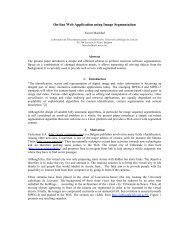motion estimation and compensation for very low bitrate video coding
motion estimation and compensation for very low bitrate video coding
motion estimation and compensation for very low bitrate video coding
You also want an ePaper? Increase the reach of your titles
YUMPU automatically turns print PDFs into web optimized ePapers that Google loves.
20 Chapter 1. Digital Video Coding at Very-Low BitRate<br />
Although the <strong>coding</strong> technique of the DFD is often similar to intra<strong>coding</strong>,<br />
Strobach has demonstrated [120] the ine ciency of applying<br />
the same technique to intra <strong>and</strong> residual <strong>coding</strong> because of the drastic<br />
reduction of the spatial correlation after <strong>motion</strong> <strong>compensation</strong>. This<br />
inadequacy can also be explained by the fact that the in<strong>for</strong>mation of<br />
an intra image is uni<strong>for</strong>mly spread out, while the contents of residual<br />
images is located in speci c areas of the images (e.g. the borders of the<br />
moving objects). For instance, Matching Pursuits [90] are designed <strong>for</strong><br />
residual <strong>coding</strong>.<br />
1.3 Coding at Very-Low BitRate<br />
Very-Low BitRate transmission can be understood as transmissions across<br />
b<strong>and</strong>widths of 5 to 64kbit=s, or sometimes up to 128kbit=s. Some of<br />
the applications which might be addressed are: wired <strong>video</strong> phones<br />
(28:8kbit=s modems <strong>and</strong> be<strong>low</strong>), wireless <strong>video</strong> phones (under 13kbit=s),<br />
Internet <strong>video</strong> conferencing (28:8kbit=s modems <strong>and</strong> be<strong>low</strong>), remote<br />
monitoring, tele-operation, tele-working,::: Appendix A presents the<br />
typical VLBR-like <strong>video</strong> sequences that are used as test sequences in<br />
the present document.<br />
The rst <strong>video</strong> <strong>coding</strong> st<strong>and</strong>ards considered higher <strong>bitrate</strong>s. For instance<br />
MPEG-1 [62] isintended to ensure domestic use quality (CD-ROM use)<br />
under 1:5Mbit=s <strong>and</strong> MPEG-2 [62] proposes digital TV broadcasting<br />
be<strong>low</strong> 10Mbit=s or HDTV at 60Mbit=s. So, what constitutes the main<br />
di erence between codecs working at such <strong>bitrate</strong>s <strong>and</strong> VLBR ones?<br />
The rst di erence was already introduced in table 1.1: in order to<br />
quickly reach <strong>low</strong> <strong>bitrate</strong>s, <strong>low</strong>er spatial <strong>and</strong> temporal resolutions are<br />
used. But another major di erence can be pointed out: to transmit<br />
(moving) pictures across high-<strong>bitrate</strong> channels, only the irrelevant part<br />
of the image(s) has to be suppressed, while VLBR compression schemes<br />
generally have to suppress more in<strong>for</strong>mation. There<strong>for</strong>e, VLBR <strong>video</strong><br />
<strong>coding</strong> introduces more artifacts. A key-issue <strong>for</strong> VLBR <strong>coding</strong> is thus<br />
an e cient management of the visual degradations that have to be accepted.<br />
The in uence of the <strong>bitrate</strong> mainly arises at the residual level:<br />
<strong>very</strong>-<strong>low</strong> <strong>bitrate</strong>s prevent the coder from sending a su cient amount<br />
of residual in<strong>for</strong>mation. The imperfections of the <strong>motion</strong> <strong>estimation</strong> &<br />
<strong>compensation</strong> phase are not entirely corrected <strong>and</strong> many artifacts remain<br />
visible.





